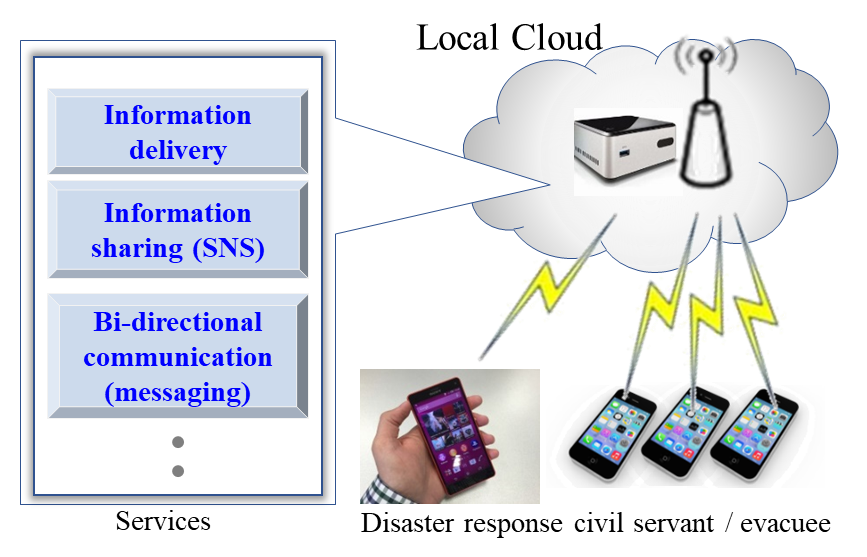Technology
Background
There has occurred an enormous number of disasters worldwide in the past. In the telecommunication or the Information and Communication Technology (ICT) sector, disaster occurrence often affects the services seriously.

Fig.1 shows a typical configuration of ICT infrastructure and its possible damage caused by disasters. Nowadays, people access the Internet through mobile devices like smartphones and/or personal computers from home. These devices are connected through the access network that comprised of the base station and/or optical fibers which interconnect subscriber’s devices and the telecom equipment in the nearby communication building. Communication buildings are mutually interconnected by optical fibers to form a transport network. Using this transport network, the Internet routers deployed worldwide in distributed manner are interconnected to form the Internet. Data-centers or huge computer systems are connected to the Internet to deliver Internet-based services like social networking service, e-Commerce service, and Information retrieval service. In the disaster situation, the components of network access including base stations and optical fibers in the disaster-affected area are damaged and/or stop operating due to a power outage. In a largescale disaster, even communication buildings, transport networks and other building blocks sometimes get damaged. These damages disrupt the ICT services like telephone and other internet-based services.
Locally Accessible Cloud System (LACS)
To fill the ICT demand-supply gap which becomes a critical issue in the disaster-affected areas, the authors proposed an architecture called Locally Accessible Cloud System or LACS. Fig.2 shows a LACS architecture. LACS is a portable system that can temporarily form an Internet-like environment in its surrounding local area where ICT services are delivered locally. People near the LACS can access the LACS functions using their smartphones to collect and share information and communicate with their families and acquaintances. The basic idea in the proposal is that LACS brings the service functions physically to local area and integrates them with newly deployed and/or survived access network to enable local people to access to the functions directly using popular ICT devices like smartphones.

Expected use cases
Table 1 shows the expected use cases of LACS. The main purpose of LACS is to quickly create a local ICT environment in a disaster situation. Disaster response officials including local government, police, and hospitals bring LACS to the site of activity and use it for communication among team members. LACS can be deployed in an evacuation center to fulfill the demand for communication there. LACS can be used as a temporary local communication tool for events and training in normal situations. People in developing areas can use LACS in daily life as a tool for local communication under the restricted Internet access environment.
LACS conforms to ITU standard L.392 and can be classed as a kind of Network-In-a-Box solutions.

Proto-type system
Fig.3 shows an outlook of the developed LACS pilot product. Table 2 shows the typical specifications of the pilot product. LACS accommodates a small server, Wi-Fi access point, a battery, and other peripheral devices in a carry case. In the server, software for communication functions is installed. The Wi-Fi access point is to make it possible for surrounding people to access LACS using Wi-Fi from their smartphone and other ICT devices. With the access point in the pilot product, users in the area with tens to a hundred meter in the line-of-sight radius can be covered. The battery is an important building block to run the LACS for hours without electric power feed from outside. The pilot product is able to operate about 8 hours in normal use without power feed from outside.


References
[1] Toshikazu Sakano, Zubair Md. Fadlullah, Thuan Ngo, Hiroki Nishiyama, Masataka Nakazawa, Fumiyuki Adachi, Nei Kato, Atsushi Takahara, Tomoaki Kumagai, Hiromichi Kasahara, and Shigeki Kurihara, "Disaster-Resilient Networking: A New Vision Based on Movable and Deployable Resource Units," IEEE Network, vol. 27, no. 4, pp. 40-46, Aug. 2013.
[2] Sakano, T.; Kotabe, S.; Komura, T.; Kumagai, T.; Shimizu, Y.; Takahara, A.; Ngo, T.; Fadlullah, Z.M., Nishiyama, H.; Kato, N. “Bringing Movable and Deployable Networks to Disaster Areas: Development and Field Test of MDRU,” IEEE Network, vol.30, no.1, pp.86-91, Jan. 2016.
[3] Recommendation ITU-T L.392, “Disaster management for improving network resilience and recovery with movable and deployable information and communication technology (ICT) resource units,” April 2016
[4] Toshikazu Sakano, Rui Teng, Kazuto Yano, Satoru Shimizu, and Yoshinori Suzuki,” A Study on a system for alleviating communication difficulty based on promptly deployable local clouds in the disaster-affected areas,” IEICE General Conference 2019, B-7-46, Mar. 2019.(in Japanese)
[5] Rui Teng, Toshikazu Sakano and Yoshinori Suzuki, “Instantaneous Networking Service Availability for Disaster Recovery,” Appl. Sci. 2020, 10(24), 9030; https://doi.org/10.3390/app10249030, 17 Dec 2020
[6] Toshikazu Sakano, Ojetunde Babatunde, Yoshinori Suzuki, Jeffrey N. Llanto, and Chandraplakash Sharma, " Feasibility study of Locally Accessible Cloud System (LACS) conducted in a remote island in Cebu, Philippines to meet the real demand for ICT under the COVID-19 pandemic. In Proceedings of the 2nd International Symposium on Disaster Resilience & Sustainable Development, Online, 24–25 June 2021.
[7] Babatunde Ojetunde, Susumu Ano, and Toshikazu Sakano, "A Practical Approach to Deploying a Drone-Based Message Ferry in a Disaster Situation," Appl. Sci. 2022, 12(13), 6547; https://doi.org/10.3390/app12136547
